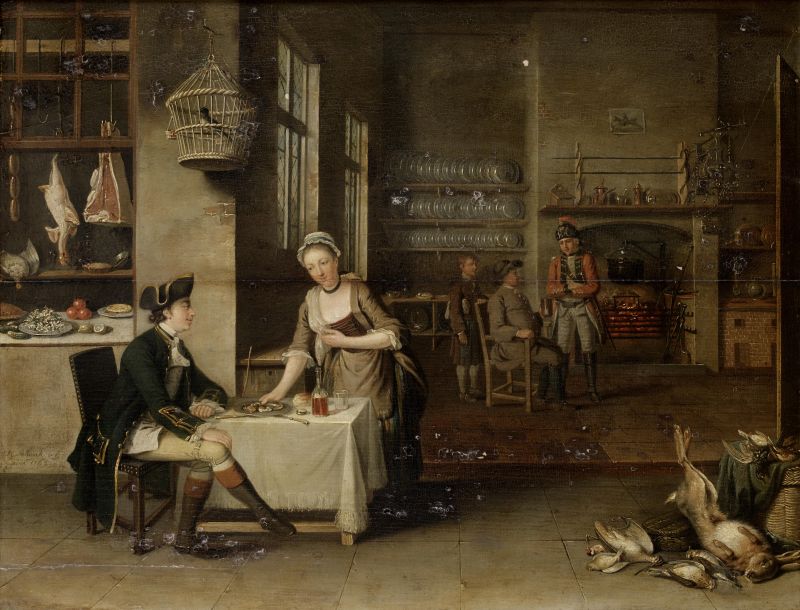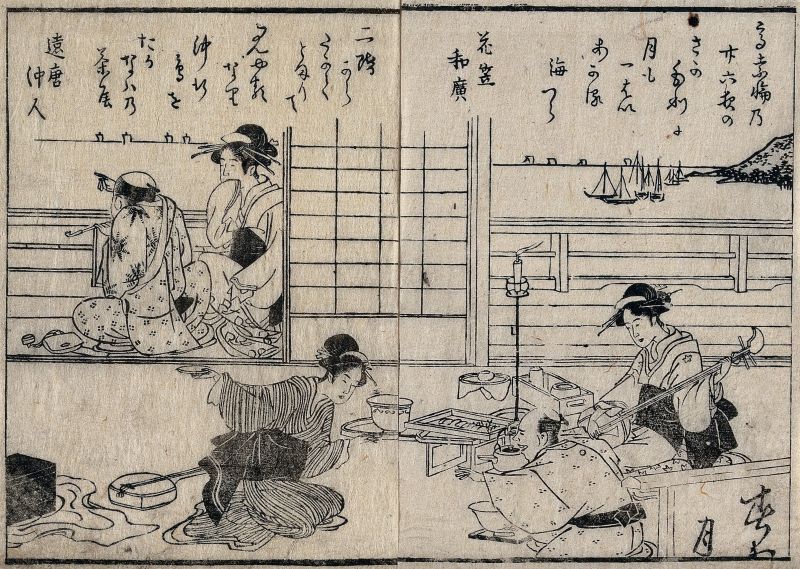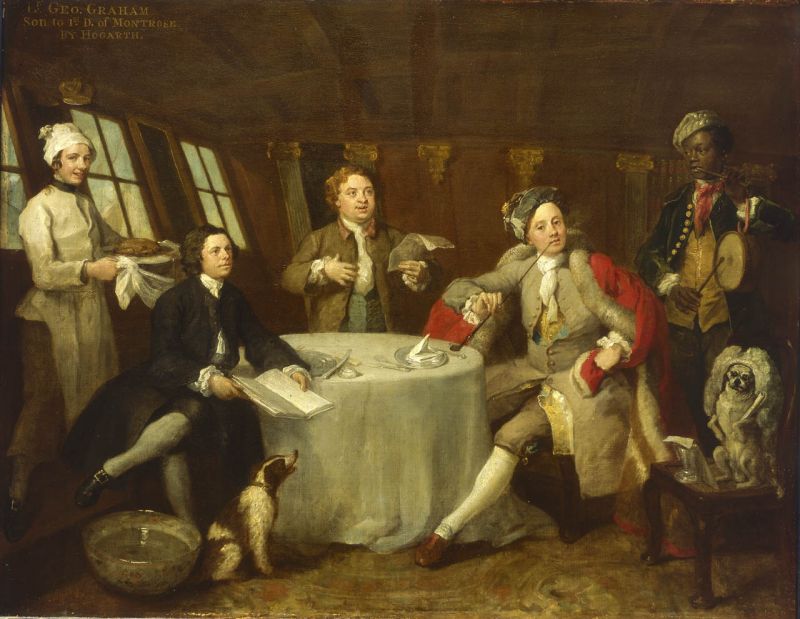ikfoundation.org
The IK Foundation
Promoting Natural & Cultural History
Since 1988


 Crowdfunding Campaign
Crowdfunding Campaignkeep knowledge open, connected, and growing on this textile history resource...
TABLECLOTHS AND MATS DURING MEALS
– Observations by 18th Century Travelling Naturalists
All sorts of food and drink during natural history journeys to more than 50 countries between 1746 and 1799, were frequently mentioned in Carl Linnaeus’ Apostles and some of their contemporaries journals, diaries, correspondence and other accounts. Either due to everyone’s daily needs, curious observations of local customs, desire for certain drinks such as coffee, tea or wine, for favourable trade purposes or general aspirations to later on produce newly discovered nourishments via collected seeds or plants in their own country. Eight of these travellers also included some brief notes from various visited regions about textile tablecloths and reed mats – or lack of such materials or different traditions altogether – which will be the focus of this essay.
 Pehr Kalm noticed, during his stay in London 1748 (2 May), how wine spots could be removed from the valuable linen, which he probably must have heard during dinners served on tablecloths. This was done by rubbing lemon juice on to the spot; alternatively, salt and a little water could achieve the same effect. Table linen was not only commonly used in well-to-do homes, but also at a tavern, judging by this somewhat later painting (1762), probably from the Westminster area in London. Oil on panel by John S.C. Schaak (Courtesy of: Wikimedia Commons, unknown ownership).
Pehr Kalm noticed, during his stay in London 1748 (2 May), how wine spots could be removed from the valuable linen, which he probably must have heard during dinners served on tablecloths. This was done by rubbing lemon juice on to the spot; alternatively, salt and a little water could achieve the same effect. Table linen was not only commonly used in well-to-do homes, but also at a tavern, judging by this somewhat later painting (1762), probably from the Westminster area in London. Oil on panel by John S.C. Schaak (Courtesy of: Wikimedia Commons, unknown ownership).Two totally different perspectives registered in Carl Linnaeus’ former students’ correspondence and travel journals, include information about meals served on the ground and a reed mat in northern Africa. Firstly, in a letter to Pehr Wargentin, Secretary of the Swedish Royal Academy of Sciences, on 8 April 1774, when Göran Rothman compared traditions at home and how he experienced food during a trip close to Tripoli:
- ‘We reached the Sheikh’s camp after three hours’ journey. He raised there a beautiful tent for me and my servant or interpreter, and treated me with an evening meal, which consisted of bread – as he quickly prepared for me – and sheep meat cooked in white sauce. The bread was made of barley flour, unfermented and thinly baked on hot stones, both in appearance and taste like our hard bread in Småland and several other provinces. The meat was very well peppered. The meal was usually arranged on the ground, and the host himself was so polite that with his own fingers he searched for the best pieces and handed them over to me, because here was no question about using spoon, knife or fork.’
Whilst, Fredrik Hasselquist – in March 1750 – explained in his journal that the reed mat had its given function among the people of Cairo, which the group experienced when they arrived at their resting place for the night, situated in a large stone building. There, the reed mat served both as floor decoration and as a tablecloth. When food was served, the guests sat in a circle on the mat, enjoying the food.
![The contemporary Swedish East India traveller Carl Johan Gethe’s journal dating 1746 to 1749, is a detailed account from when he already as an 18-year-old had the opportunity to go to China within his military profession. Furthermore, his very well-preserved journal includes illustrations, like this example from Canton [Guangzhou] giving a glimpse of a meal served without a tablecloth – to be compared with the apostle Pehr Osbeck’s notes from a few years later. (Courtesy of: National Library of Sweden, M 280).](https://www.ikfoundation.org/uploads/image/2-gethe-664x799.jpg) The contemporary Swedish East India traveller Carl Johan Gethe’s journal dating 1746 to 1749, is a detailed account from when he already as an 18-year-old had the opportunity to go to China within his military profession. Furthermore, his very well-preserved journal includes illustrations, like this example from Canton [Guangzhou] giving a glimpse of a meal served without a tablecloth – to be compared with the apostle Pehr Osbeck’s notes from a few years later. (Courtesy of: National Library of Sweden, M 280).
The contemporary Swedish East India traveller Carl Johan Gethe’s journal dating 1746 to 1749, is a detailed account from when he already as an 18-year-old had the opportunity to go to China within his military profession. Furthermore, his very well-preserved journal includes illustrations, like this example from Canton [Guangzhou] giving a glimpse of a meal served without a tablecloth – to be compared with the apostle Pehr Osbeck’s notes from a few years later. (Courtesy of: National Library of Sweden, M 280).Pehr Osbeck made thorough descriptions of traditions in the Canton area in 1751, among many matters, including the lack of tablecloths, etc, among the well-to-do inhabitants as seen from his European perspective:
- ‘Those who are somewhat higher in quality make use of tables and chairs; but have neither tablecloth, knife, fork, or napkins; but handkerchiefs supply the place of the latter. Knives are unnecessary at the table since they eat no bread. Fish, bacon, &c. are cut into little pieces, and put upon the table like the greens, in tea dishes, or little pots, that every one may take what he likes best. Spoons are of use. Their meat has no sauce, nor do they make soups, or the like. Two little sticks for each person, and some tea dishes or pots with meat cut in pieces, make the whole arrangement in a collation.’
Another East India traveller was the Linnaeus apostle Olof Torén, hired as ship’s chaplain on two voyages with the Swedish East India Company, but he also found time to collect natural history specimens and noticed various everyday traditions along the route. For instance, during the second journey at a stop-over in Suratte, India 1750, he compared the bread with similar ones in an area of Sweden where he was born and gave a brief note about a tablecloth. ‘They eat sitting on a mat, spread on the floor; and lay the tablecloth on the same place. Rice serves them instead of bread, and is either boiled in pots, or kneaded and baked on plates, like the thin bread usual in Bohuslän.’
 Carl Peter Thunberg during his time in Japan 1775-76 made a detailed notation in his journal about Japanese traditions: ‘Their soft floor-mats serve them for chairs and beds. A small table, about 12 inches square, and four in height, is set down before each person in company at every meal. Here it may be proper to observe, that whereas most of the other nations in India sit with their legs laid across before them, the Chinese and Japanese lay their feet under their bodies, and make a chair of their heels.’ Comparable with this Japanese woodcut, dating circa 1780 by Kitagawa Utamaro (1753?-1806) (Courtesy of: Wellcome Library no. 566191i).
Carl Peter Thunberg during his time in Japan 1775-76 made a detailed notation in his journal about Japanese traditions: ‘Their soft floor-mats serve them for chairs and beds. A small table, about 12 inches square, and four in height, is set down before each person in company at every meal. Here it may be proper to observe, that whereas most of the other nations in India sit with their legs laid across before them, the Chinese and Japanese lay their feet under their bodies, and make a chair of their heels.’ Comparable with this Japanese woodcut, dating circa 1780 by Kitagawa Utamaro (1753?-1806) (Courtesy of: Wellcome Library no. 566191i). An illustrative example of table linen onboard a contemporary ship, was depicted on this oil on canvas from 1745 by William Hogardt (1697-1764) – ’Captain Lord George Graham (1715-47) in his Cabin’. This conversational painting demonstrates the relaxed interior of the captain’s cabin on the 60-gun HMS Nottingham, anchoring in a harbour as visible ship sails can be glimpsed from the windows, whereof the fine dining, musical entertainment, Hogardt’s pug dog etc. However, to my knowledge, via in-depth research of the seventeen Linnaeus Apostles’ and their colleagues’ travel journals etc, tablecloths were not mentioned onboard ships in any form. Even if this commissioned painting includes an elegantly laid table one may assume that it was rare – for practical reasons – to use fine table linen on lengthy voyages by ship. (Courtesy of: National Maritime Museum, BHC2720. Wikimedia Commons).
An illustrative example of table linen onboard a contemporary ship, was depicted on this oil on canvas from 1745 by William Hogardt (1697-1764) – ’Captain Lord George Graham (1715-47) in his Cabin’. This conversational painting demonstrates the relaxed interior of the captain’s cabin on the 60-gun HMS Nottingham, anchoring in a harbour as visible ship sails can be glimpsed from the windows, whereof the fine dining, musical entertainment, Hogardt’s pug dog etc. However, to my knowledge, via in-depth research of the seventeen Linnaeus Apostles’ and their colleagues’ travel journals etc, tablecloths were not mentioned onboard ships in any form. Even if this commissioned painting includes an elegantly laid table one may assume that it was rare – for practical reasons – to use fine table linen on lengthy voyages by ship. (Courtesy of: National Maritime Museum, BHC2720. Wikimedia Commons).As the final of the travelling Apostles, Adam Afzelius, during his very last diary entrance on 25 May 1799, mentioned how luxurious his journey ended on his way home to Uppsala via a visit at the wealthy Chamberlain Anker in Bogstad, Norway, after ten years abroad – in England, Guinea and Sierra Leone. ‘The dinner was sumptuous & even extravagant, particularly in regard to wine, for we had not less than 12 different sorts of the most delicious, as Porto di Ramo, Porto di Cape wine, Tokay, besides Champaign, Madeira, Claret, old Hoc, &c. &c. and at last Bishoff.’ Even if the linen tablecloth was not mentioned, one may assume that it was of the finest quality woven in damask or diaper.
Sources:
- Hansen, Lars ed., The Linnaeus Apostles – Global Science & Adventure, eight volumes, London & Whitby 2007- 2012. (Quotes and info: Kalm’s journal – Vol. Three p. 230. Rothman’s letter & Afzelius’ journal – Vol. Four pp. 81 & 658. Vol. Seven Osbeck’s journal & Toren’s letter IV – Vol. Seven pp. 118 & 244).
- Hansen, Viveka, Textilia Linnaeana – Global 18th Century Textile Traditions & Trade, London 2017 (pp. 51-52 & 188).
- Kungliga Biblioteket, Stockholm, Sweden (National Library of Sweden); ‘Dagbok hållen på Resan till Ost Indien, Begynt den 18 octobr: 1746 och Slutad den 20 Juni 1749’ by Carl Johan Gethe (M 280, Tab: XI).
- Osbeck, Peter [Pehr], A Voyage to China and the East Indies, 2 vol., London 1771.
- Thunberg, Carl Peter, Travels in Europe, Africa and Asia, performed between the years 1770 and 1779. vol I-IV., London 1793-1795 (Vol. III).
- Wellcome Library (Online image no. 566191i & information on catalogue card).
More in Books & Art:
Essays
The iTEXTILIS is a division of The IK Workshop Society – a global and unique forum for all those interested in Natural & Cultural History.
Open Access Essays by Textile Historian Viveka Hansen
Textile historian Viveka Hansen offers a collection of open-access essays, published under Creative Commons licenses and freely available to all. These essays weave together her latest research, previously published monographs, and earlier projects dating back to the late 1980s. Some essays include rare archival material — originally published in other languages — now translated into English for the first time. These texts reveal little-known aspects of textile history, previously accessible mainly to audiences in Northern Europe. Hansen’s work spans a rich range of topics: the global textile trade, material culture, cloth manufacturing, fashion history, natural dyeing techniques, and the fascinating world of early travelling naturalists — notably the “Linnaean network” — all examined through a global historical lens.
Help secure the future of open access at iTEXTILIS essays! Your donation will keep knowledge open, connected, and growing on this textile history resource.
been copied to your clipboard




– a truly European organisation since 1988
Legal issues | Forget me | and much more...
You are welcome to use the information and knowledge from
The IK Workshop Society, as long as you follow a few simple rules.
LEARN MORE & I AGREE







